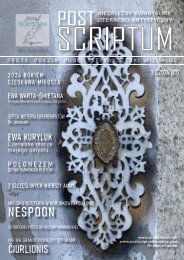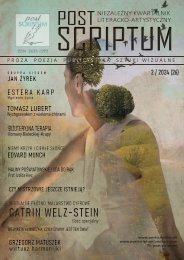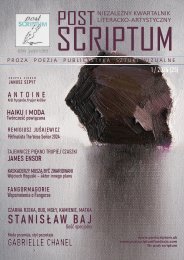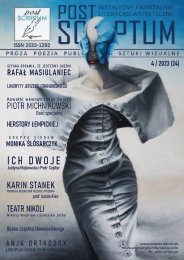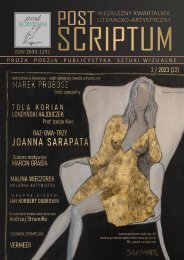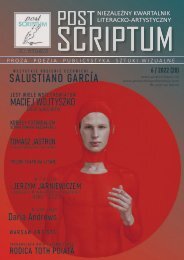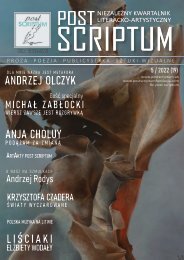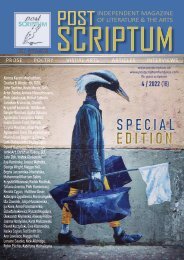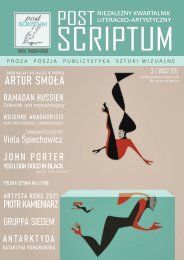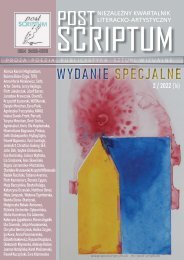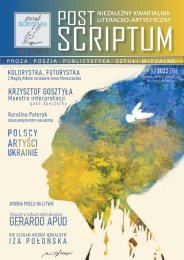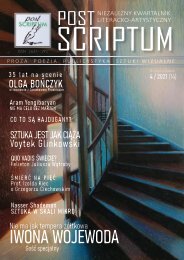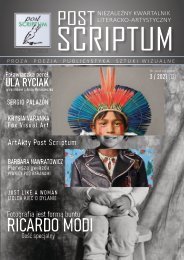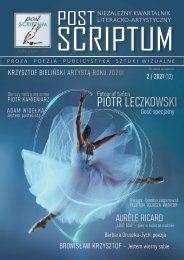POST SCRIPTUM English__ Feb 2021
POST SCRIPTUM - Independent MAGAZINE OF LITERATURE & ARTS - English version. POST SCRIPTUM - Niezależne pismo artystyczno-literackie tworzone przez polsko-brytyjski zespół entuzjastów, artystów i dziennikarzy. Zapraszamy do lektury.
POST SCRIPTUM - Independent MAGAZINE OF LITERATURE & ARTS - English version.
POST SCRIPTUM - Niezależne pismo artystyczno-literackie tworzone przez polsko-brytyjski zespół entuzjastów, artystów i dziennikarzy. Zapraszamy do lektury.
You also want an ePaper? Increase the reach of your titles
YUMPU automatically turns print PDFs into web optimized ePapers that Google loves.
Damiano Errico was born in Caserta in 1970. He attended<br />
the Art Institute of S.Leucio (CE), where he met the painting<br />
master Bruno Donzelli and spent a long period as an<br />
assistant in the master’s studio learning painting techniques.<br />
After graduating, he enrolled at the Academy of Fine Arts<br />
in Naples, where he studied photography with Mimmo Jodice.<br />
From the first meeting with the master till now, not a day goes<br />
by without photography. He often exhibits in galleries and<br />
museums, and carries out many photographic workshops<br />
and seminars in Italy and Europe.<br />
How did you become an artist?<br />
It happened in very early childhood – I was 6/7 years<br />
old, when I used to spend my days in my father’s tailor’s<br />
shop, yes... my father was a tailor and created tailor-<br />
-made clothes. I very often played with fabrics and<br />
always drew. At that stage my passion for creativity was<br />
born. I watched how, from a piece of cloth, a dress was<br />
born. Today I try to “dress” my models with light. Light<br />
does not strip bodies but dresses them with poetry.<br />
Beautifully said…<br />
When it comes to education, you started your<br />
adventure with art with painting (studying painting<br />
under the supervision of Bruno Donzella). I read that<br />
you weren’t interested in photography until you met<br />
the great photographer Mimmo Jodice at the Academy<br />
of Fine Arts in Naples, where you were studying. What<br />
did Mimmo Jodice say that made you change your<br />
mind after one conversation?<br />
I did not like photography. I wanted to become a painter.<br />
I thought photography was a minor/trivial art. Mimmo<br />
Jodice made me understand that photography is not<br />
made up of numbers and formulas, but of poetry and<br />
culture, of art history, of emotions. I remained in ecstasy.<br />
I immediately bought a camera and since that day I have<br />
always taken photos.<br />
Mimmo Jodice is known for photographing<br />
contemporary cultures: landscapes, cities, industrial<br />
buildings, etc., the human figure is rarely physically<br />
present in his works. You mainly photograph people.<br />
What influenced your own style the most?<br />
The master Jodice has often portrayed classical<br />
sculptures, he managed to give life to a block of marble.<br />
I want to convey the same emotions, but in the opposite<br />
way. I want to transform people, models into paintings<br />
and sculptures. From Mimmo Jodice I learned how to<br />
look for feelings in people, landscapes and sculptures.<br />
Yes, your photos look like the works of<br />
great masters. Do you have a favourite master?<br />
I love all the masters who have created masterpieces,<br />
but in particular I love Caravaggio for his theatricality<br />
and his realism, Vermeer for his natural light, Bernini for<br />
his pathos in stone and Canova for the pursuit of beauty.<br />
<strong>POST</strong> <strong>SCRIPTUM</strong><br />
45




